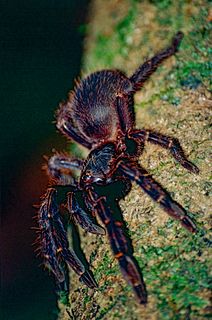Catopsalis is a genus of extinct mammal from the Paleocene of North America. This animal was a relatively large member of the extinct order of Multituberculata. Most Multituberculates were much smaller.

Phobaeticus is a genus of Asian stick insects comprising over 25 species. It includes some of the longest known insects, including Phobaeticus chani.

Anomiidae is a family of saltwater clams, marine bivalve molluscs related to scallops and oysters, and known as anomiids. It contains seven genera.
Foliata, a Latin word meaning leafy, may refer to:
Foliatum, a Latin word meaning leafy, may refer to:
C. foliatus may refer to:
E. foliatus may refer to:
Foliatus, a Latin word meaning leafy, may refer to:

The skeleton tarantula, Ephebopus murinus, is a species of spider belonging to the family Theraphosidae (tarantulas), sub-family Aviculariinae. A New World species, it is native to several South American countries. Its common name is derived from the skeleton-like markings on its legs.
Cupiennius foliatus is a banana spider species first documented in 1901 and found in Costa Rica and Panama.
Paraamblyseius is a genus of mites in the Phytoseiidae family.
Evanssellus is a genus of mites in the family Ologamasidae.
Gamasiphis is a genus of mites in the family Ologamasidae.
Evanssellus foliatus is a species of mite in the family Ologamasidae.

Ephebopus is a genus of northeastern South American tarantulas that was first described by Eugène Louis Simon in 1892. Its relation to other tarantulas is one of the most uncertain in the family, and it has been frequently moved around and has been placed in each of the eight subfamilies at least once.

The Aviculariinae are a subfamily of spiders in the family Theraphosidae (tarantulas). They can be distinguished from other theraphosids by a number of characters. Their legs have no or few spines on the underside of the tibial and metatarsal joints of the legs. The last two leg joints have brushes of hairs (scopulae) that extend sideways, particularly on the front legs, giving them a spoon-like (spatulate) appearance. Females have two completely separated spermathecae.

Ephebopus cyanognathus, known as the blue fang tarantula, is a species of tarantula. It is endemic to French Guiana.

Ephebopus rufescens, known as the red skeleton tarantula, is a species of tarantula. It is found in French Guiana and Brazil.
Ephebopus uatuman is a species of tarantula, native to Brazil.
Rick C. West is a Canadian arachnologist with a main expertise toward tarantula spiders. West was born in Victoria, British Columbia. He has been interested in spiders since childhood, and collected his first tarantula, Aphonopelma eutylenum at the age of 13. He worked primarily as a Chief Constable for a local Animal Humane Society, but also have been involved with the collecting, breeding, rearing and photography of theraphosid spiders. West has traveled to over 27 countries to document and study them in their environment, has been a host, presenter and co-producer in several tarantula documentaries and has also described several new species.





